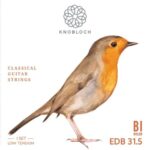This post is also available in:
![]() 日本語 (Japanese)
日本語 (Japanese)
I tried an expensive strings that have recently appeared on the market. They are Dogal’s Maestrale.
It is said that the blue treble strings are distinctive and sound good.
In conclusion, it was a unique string anyway.

The following article summarizes the string reviews/impressions/information articles in this blog

- Beautiful packaging, tightly sealed bass strings
- Oh, it’s got seven strings…?
- Not as beautiful looking as I thought it would be, treble strings
- Bass strings look normal.
- The first and second strings are very stretchable
- Thick and loud sound
- The one and only string, great when it fits.
- PS: I changed to Diamante because I couldn’t stand the metallic sound of the first string.
- PS: Blue polymer strings squeak, overall rough and not sensitive
- PS: The bass string life was normal.
Beautiful packaging, tightly sealed bass strings
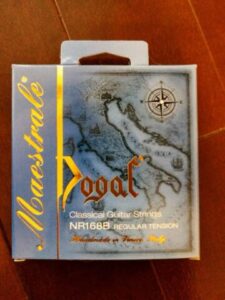
The price is about 3,000 yen. I think it is one of the most expensive strings in the market.
The packaging is also gold and has a solid box, giving it a high quality feel.
The name of the string, Maestrale, does not come from the word “maestro”, but from the wind that blows from the northeast of Italy. According to Wikipedia,
A local wind blowing from the northeast in Italy. It means “main (wind)”, and is a respectful reading of the wind blowing from the direction of Rome and Venice in the Ionian Sea. In Japanese, the French name Mistral is generally used.
I thought for sure it came from Maestro.
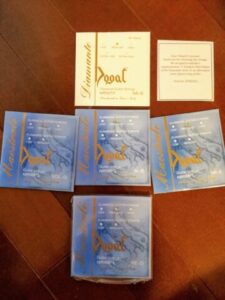
Here’s what’s inside. The three bass strings are packed together in a tight plastic package. It is safe to store for a long time.
Oh, it’s got seven strings…?
If you look closely at the picture above, you’ll notice that there are four treble strings.
What’s this? I thought, and read the enclosed message.
Some people don’t like the first string, so I put a free Dogal’s Diamante first string on it.
It was written on it. I remembered that Pro-Arte composites came with both composite and nylon strings for the third string. It says “free” (complimentary), but to be honest, I’d like to see a discount on those strings since they are expensive.
Not as beautiful looking as I thought it would be, treble strings
But since we’re here, here’s how they look compared.
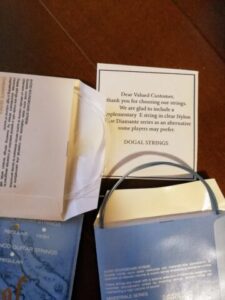
The lights are a bit reddish, but obviously they look different. Diamante (upper left) looks like a normal nylon string, but Maestrale is blue. It is not transparent blue, but opaque blue. It was said that the blue color represents the Italian wind and sky, so I thought it was a refreshing transparent blue. But it was actually non-trasparent blue…
I bought a set of Diamante strings separately, so I’ll review them there, but they are rather thin and flexible. I thought it would have a different feel because it’s nylon mixed with carbon, but it was normal. The Maestrale is so special that all the others look normal.
Also, the thickness of Maestrale is thicker and less supple. I don’t know what it is, but I can’t find the best way to describe it, but it feels like plastic of a plastic model. If I had to guess, I’d say it’s similar to the coffee-colored 3rd string of the Pro Arte composite.
This is what it looks like when all the strings are set.
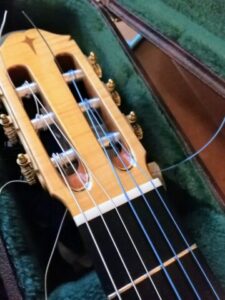
It’s so strange. It looks like a toy guitar or an electric or acoustic guitar (lol). If I may say so, I would have liked it to look a little more luxurious.
Bass strings look normal.
The bass strings, on the other hand, look normal. The following picture shows a comparison between a Pro-Arte Dynacore and a Dogal Diamante 6 string:
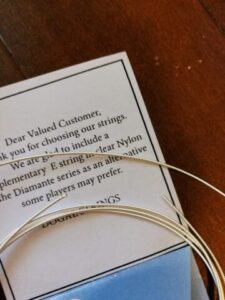
The strings look a little reddish, it’s a lighting issue. Both are a beautiful silver color.
The core wire is not blue, and it looks like a normal wound string. The thickness is also a little thick. It’s normal.
I mean, again, the impact of the treble strings is so great that everything else seems normal.
The first and second strings are very stretchable
When I put it up, it looks very odd as shown in the picture above.
Aside from that, I’m impressed that the 1st and 2nd strings are getting longer and longer, and for some reason the 3rd string isn’t, but the 1st and 2nd strings are still getting longer and longer after about an hour of playing. In general, one hour of playing is enough to make it stable…
I’m pretty sure I read in a review of a Japanese guitar magazine that it takes 3 or 4 days to stabilize, but if you’re close to the show, you should pay attention to when to replace strings.
Thick and loud sound
It is the sound that is important, but the treble string sounds very loud as it is mentioned. It is not thin and sharp like carbon strings, but it sounds thick and loud.
Because of this, they don’t sound sharp even in high position like carbon strings, but they sound soft like nylon strings. But they don’t sound muffled like nylon strings, and they sound very loud.
In terms of sound character change, it’s hard to change as much as or more than carbon strings. They sound the same no matter how close or far they are from the fretboard.
The bass strings also sound good. This may depend on the guitar, but I’m impressed with how well the 6th string sounds. On a Savarez or Pro Arte, the 6th string is a bit quiet, but it sounds great. The sound of the guitar itself comes out loud, not a metallic crunch.
The tension feels a little strong. It may be because it’s thicker, and the treble strings is thick in particular. It says on the back of the package that it is easy on the guitar, but…. The impression may change when the strings become stable.
The one and only string, great when it fits.
My overall impression is that it’s just a unique string.
Especially for the treble strings, the material is completely different from others, and you will get a unique look and sound. If you like the sound, you won’t be able to use anything else.
The bass strings also sound great. This one doesn’t look or sound much different, but I’ve never experienced any other string that sounds this good.
Personally, I like the bass strings. The treble strings, well, I don’t mind them, but I’m not so sure I like them at the moment, considering their appearance and price. I think.
I’d like to add a note about the longevity of the strings as well, as my opinion may change as they stabilize.
PS: I changed to Diamante because I couldn’t stand the metallic sound of the first string.
At first I was using a blue Maestrale for the first to third strings, but I started to notice a metallic sound on the first string, not so much on the second and third strings, but the first string is a bit harsh.
I had no choice but to put on the first string of the diamante that came with the guitar.
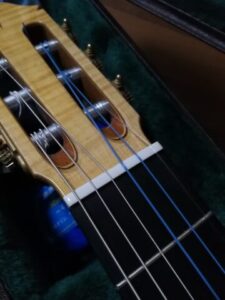
I didn’t realize how much more relaxing it would look with just one string being a regular string.
The sound is not so loud as all-Maestrale case, but a calm sound. Surprisingly, I don’t feel uncomfortable, but it’s strange that the 2nd and 3rd strings are more loud than the 1st string.
PS: Blue polymer strings squeak, overall rough and not sensitive
The treble strings made of blue polymer are a feature of this set, but the strings are not very slippery and make an unpleasant squeaky sound when the left hand slurs or the flesh of the right hand slides over the strings.
I can’t find a good analogy, but I guess you could say it’s like sliding your finger over the smooth plastic of a brand new appliance.
It’s a bit of a bummer because it’s all noise and it’s slippery and hard to play.
Also, when I use this string all the time, it sounds too loud and it seems rough on the contrary. It seems that there are some pieces that suit it and some pieces that don’t.
PS: The bass string life was normal.
I was hoping for a longer lifespan since they are expensive strings, but the lifespan was normal. After two weeks of playing one hour on weekdays and two hours on weekends, the bass strings lose their shine.
They sound loud and are interesting strings, but they are a bit expensive.



